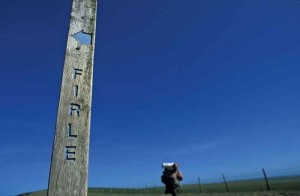Get Into: Long Distance Trails
Camp, Gear, Hike, News — By Outdoor Adventure Guide on March 15, 2012 at 4:17 pmThey’ve been around since mankind evolved, mainly because there weren’t any airports in the Stone Age. Even though it’s so much faster to use almost any other form of transport, walking all or part of classic long distance trails is getting increasingly popular as we increasing seek to slow down and suck up the scenery.
What are they?
In many cases they’re the routes pre-industrial society used to get to important destinations. Back in the day very few people travelled, unless it was your job to communicate with far flung places. Pilgrimages or trade are behind many of the current trails. Several cross countries; England and Wales has 15 official National Trails totting up to 2500 miles of paths, byways and bridleways, plus smaller roads open to all traffic.
In Europe there are some epics, like the high-altitude GR 20 down the spine of Corsica, the Appalacian Trail made famous by Bill Bryson in his book ‘A Walk in the Woods’ and the Way of St James to Santiago de Compostella in Spain.
Because these routes are so popular, there are related networks to keep you fed, watered and housed, and there are increasing numbers of organisations who will do all the planning. Some f these allow you to cover the whole distance in a shorter time, leapfrogging various sections so a 600-mile, six week journey can be completed within a regular 10 day holiday, leaving some time to put your surprised feet up at the end.
Trails in the UK
They’re everywhere! Nationaltrail.co.uk has the official list and that’ll get you around England and Wales, and it’s an excellent website full of info and inspiration. For Scotland, the West Highland Way from Glasgow to Ben Nevis is a fine introduction to the country, the walking and long distance paths in general. Others include the Coast to Coast, the Wainwright version of which we covered in OAG 86. The Pennine Bridleway allows cyclists and horses along its entire length, so that’s a possibility if you decide walking isn’t your bag. All OS maps have the trails marked on them.
Why do it?
There are many reasons for setting out to cover a long distance path – a personal test, pilgrimage or a chance to step outside everyday life seem to be the most popular. Is there a better way to enjoy a country, slowly absorbing the landscape’s changes?
Classic routes are well marked, full of companionship and easy to access. Your effort wants to be tilted towards getting physically prepared, so knowing where you’re stopping each night, what to take and how long you should be on the road for each day takes a load off you mind, and indeed lightens the one on your back.
Essential gear
Trail shoes
Trainers can be up to the job, but approach shoes are designed to handle higher loads and more varied terrain, over a longer period of time. They should be comfortable and light, and offer a real alternative to your boots. You’ll also wear them in the evenings. Here’s a Hanwag Approach GTX.
Trekking Boots
It depends where your trail takes you as to what level of boot you need. Trekking/walking boots like Scarpa’s Kinesis will easily handle long days across varied terrain. These have a brethable lining and are lasted, so the sole can be replaced more easily if you wear it out.
50+litre Pack
Stable, the right size for your back and not too big is the way ahead here. Make sure your hips are taking the load and it feels stable when loaded. Deuter’s Aircontact 65+10 is fully specced and as tough as you’ll need.
Maps
To get specialist maps with the trails marked on them, try that paragon of knowing where you are, Stanfords Maps and Books, in London.




 Tweet This
Tweet This Share on Facebook
Share on Facebook Digg This
Digg This Bookmark
Bookmark Stumble
Stumble



[...] walking shoes? Just enter below and let us know your favourite trail! Here’s more info on long distance paths if you need any [...]